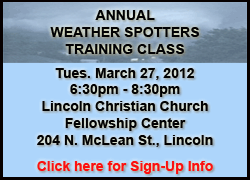|
Preparedness critical as severe weather season is upon us
Tornado
warning system test at 10 a.m. Tuesday
 Send a link to a friend
Send a link to a friend
[March 03, 2012]
Severe storms, flooding and tornadoes wreaked havoc across much
of our nation, including the state of Illinois, in 2011. Nearly
1,700 tornadoes affected our country last year, with a heavy toll on
life and property. Tornadoes killed 550 people in the U.S. during
2011 -- the most since 1925 -- and more than 5,400 were injured.
Property and crop losses due to tornadoes and severe thunderstorm
winds exceeded $10 billion nationwide, the most on record.
|
|
 Even though it is only early March, it already looks like 2012 is
taking over where 2011 left off. Deadly tornadoes ripped through
southern Illinois during the early morning Wednesday, illustrating
that these storms can hit any time of the day or year. Even though it is only early March, it already looks like 2012 is
taking over where 2011 left off. Deadly tornadoes ripped through
southern Illinois during the early morning Wednesday, illustrating
that these storms can hit any time of the day or year.
To help the citizens of Illinois be more aware of the dangers of
severe storms, the National Weather Service, has declared the week
of March 4-10 to be Severe Weather Preparedness Week in the state of
Illinois.
In addition, the annual statewide "tornado drill" is scheduled
for Tuesday at 10 a.m. Illinois NWS offices will send a "test"
tornado warning at that time to local media outlets through the
Emergency Alert System, and to those with weather alert radios.
People are encouraged to use this time to practice their tornado
safety plans at home, schools, businesses and anywhere groups
gather. Many local communities will also test their outdoor warning
sirens during this tornado drill.
The Illinois Emergency Management Agency is also taking part in
preparedness efforts by offering safety tips on the state's
preparedness website, www.ready.illinois.gov, during the entire month
of March.

People across the state can also enter a contest on the Ready
Illinois website to win one of more than 100 weather alert radios.
The radios were purchased and donated by the Illinois Emergency
Services Management Association, a nonprofit organization of
statewide emergency managers.
"Outdoor warning sirens are a small part of the warning process
during threatening weather, not the only part," said Chris Miller,
warning coordination meteorologist with the NWS in Lincoln. "Around
30 percent of all tornadoes occur at night, when it is difficult to
hear the outdoor sirens in your home -- especially while asleep.
Weather alert radios will wake you up and give you potentially
life-saving warnings. They are like having your own personal storm
siren," Miller said.
Illinois averages 46 tornadoes and hundreds of reports of large
hail and wind damage each year. We cannot stop severe storms from
occurring, but there is something that everyone can do to prepare
for these inevitable forces of nature:
[to top of second column] |

-
A WATCH means that
tornadoes or severe thunderstorms are possible, and you need to
watch the weather closely.
-
A WARNING means
that a tornado or severe thunderstorm has been detected by radar
or has been reported by a trained storm spotter. Seek safe
shelter immediately if your location is in the path of the
storm.
-
Use several
sources to receive warning information -- don't just rely on
sirens. Weather alert radios, local broadcasters,
weather-related Web pages, social media, and computer and phone
apps are a few suggestions.
-
Stay alert for the
latest hazardous weather information, especially at night or if
traveling.
-
Identify safe
indoor shelters. A basement is best. If you don't have a
basement, go to the lowest possible floor in a closet or
hallway, away from windows and exterior doors. If traveling, get
to a nearby building quickly. If none is available, as a last
resort, lie flat in a ditch and protect your head.
-
Storm warnings are
issued for portions of counties. Know the name of the county you
live in and the counties you travel through.
-
If it is safe to
do so, contact family members and friends when you become aware
of a severe thunderstorm or tornado that may threaten them.
For more information about being adequately prepared for severe
weather, visit the NWS Lincoln "Severe Weather Preparedness" Web page at www.weather.gov/Lincoln/?n=svr-prep.
Click here for "Severe
Weather Fact Sheet."
[Text from National Weather Service,
Lincoln office]

 |